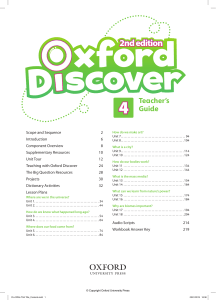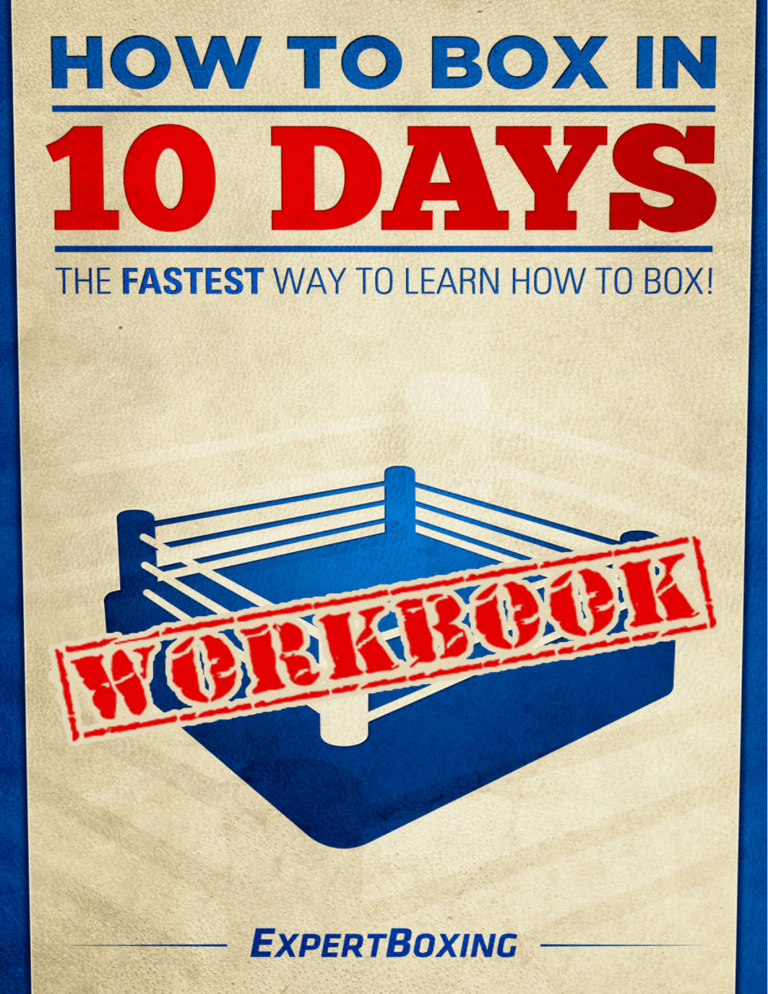
au t h o r n a m e Book template An InDesign template for books, eBooks, papers and reports This template is designed by Otto Coster and provided to you by Smashing Magazine Notes This workbook is simply a guide for beginners. After you finish the 10-day course, you are free to follow the weekly workout plan listed in the book or the one that your trainer gives you. You can re-use whatever drills here or keep them as a reference for future training. With time, every boxer will eventually create his own workout routine. Training Precautions for Beginners Safety first Warm-up, stretch and shadowbox before you start the strenuous exercises. Warming up actually increases your performance and reduces the chance of injury. Don’t be lazy; this is how athletes get hurt all the time. Do only as much exercise as you can. Feel free to do less or substitute exercises. Do what is comfortable for you. Drink lots of water before the workout. During the workout, only take small sips. Focus on technique Focus on developing good technique; strive for quality, not quantity. Learn to be effective and efficient. Your first priority is to learn the skill; the second priority is to get in shape. Do as much as you can. Read the book if you need more detailed explanation on the drills. Lose the Ego You are here to learn, not showoff. If you are dedicated enough, one day you will get to prove to the world how great you are...inside the ring. Until then, stay humble and ask for help when you need it. Ask other boxers for tips, ask sparring partners to slow down, and trust your trainer even when you don’t agree with him. Give yourself every opportunity to learn from those who know something you don’t. How to Box in 10 Days | Workbook 2 Day 1 - Stance & Footwork Footwork Drills Straight Line Drill (1 round) • Move forwards and backwards along a line (or imaginary) line on the floor without crossing over the toe-heel alignment line. Footwork Movement Drill (2 rounds) • 1st round: move around a heavy bag or a partner, maintaining an arm’s distance at all times. Use all your footwork techniques. • 2nd round: move freely across the gym anywhere you like using any footwork you like. Foot-Tag (2 rounds) • Move around with a partner in the ring and try to “tag” each other’s feet. Easy Workout • Run 1 mile and jump rope for 1 round (can be done as warm-up or warm-down) • 100 push-ups, 100 crunches, 100 jumping jacks, 100 squats How to Box in 10 Days | Workbook 3 Boxing Stance Checklist Is everything in place? LOWER BODY • Toe-heel alignment • Stance is high & heavy • Front foot 30 degrees? back foot 45 degrees? • Knees slightly bent, back heel lifted? • Weight is 50-50? UPPER BODY • Angle the body • Drop the head • Palms covering chin, not the eyes • Elbows in • Everything relaxed? Good job! You’ve mastered the boxing stance! Now you’re ready to move! How to Box in 10 Days | Workbook 4 Footwork Checklist Can you do the basic steps? • STEP-DRAG forwards, backwards, sideways, circling • PIVOT off the front foot: clockwise & counter-clockwise • BOUNCE in & out, side-to-side • SHUFFLE forwards, backwards, and side-to-side Think you’re slick? Try these tricky footwork combinations... • Step in, pivot CW, step back • Step back, pivot CW, step back • Bounce IN, bounce OUT, pivot CW • Step in or out, pivot CW, right step • Back step, left step, pivot CW • Back step, pivot CCW, left step • Step in, pivot CW, pivot CCW Can you do all these without getting tired? Try to make up some of your own! These footwork combinations will be useful later when you’re evading punches at close range. Having fun? Time to learn the punches! How to Box in 10 Days | Workbook 5 Day 2 - Straight Punches Warm-up • Run 1 mile and/or jump rope for 1 round. Footwork Drills • Footwork Movement (2 rounds) - practice your footwork by moving around. • Foot Tag (2 rounds) Jab Drills • Mitts (3 rounds) - practice your jab and right cross on the mitts. First round is for jabs only. • Wall drill (1 round) - standing with your front shoulder along the wall. Throw step-jabs as you walk straight forward. The wall prevents your elbow from flying out sideways. • Jumping jabs along the ropes (1 round) - Bag Work • Heavy bag (3 rounds) - use only straight punches. First round is for jabs only. • Double-end bag (3 rounds) use only straight punches. First round is for jabs only. Easy Workout • Jump rope (1 round) • 100 push-ups, 100 crunches, 100 jumping jacks, 100 squats • Shadowbox (3 rounds) - straight punches only. How to Box in 10 Days | Workbook 6 Straight Punches Checklist Can you... • Throw a jab with full rotation? • Throw a jab WITHOUT lifting your hips? • Keep your chin behind the shoulder when you jab? • Throw a body jab without looking down at the body? • Throw a hard right hand into the air without falling off balance? • Throw a 1-2 into the air without falling off balance? • Throw a 1-2 without dropping your right hand when you jab? • Throw a double jab while stepping forward on both jabs? • Throw a pivot jab without lifting your chin? • Throw a backstep jab without lifting your chin? Form and technique is the most important. I hope you’re ready for the trickier punches: hooks and uppercuts! How to Box in 10 Days | Workbook 7 Day 3 - Curved Punches Warm-up • Run 1 mile and/or jump rope for 1 round. • Shadowboxing (3 rounds) - move around using footwork and straight punches. Mitt Drills • Straight punches (2 rounds) - warm up on the mitts using straight punches. • All punches (3 rounds) - throw using all punches Bag Work • Heavy bag (3 rounds) - use all punches. First round is for jabs only. • Double-end bag (3 rounds) use all punches. First round is for jabs only. Easy Workout • Jump rope (2 rounds) • 100 push-ups, 100 crunches, 100 jumping jacks, 100 squats • Shadowbox (3 rounds) - using footwork and all punches How to Box in 10 Days | Workbook 8 Curved Punches Checklist Can you... • Throw a left hook with full body rotation? • Throw a left hook with a horizontal fist? • Throw a left hook with a vertical fist? • Throw a left hook without dropping your right hand from your chin? • Throw a jab-cross-hook combination without dropping your right hand from your chin? • Throw an uppercut with full body rotation? • Throw an uppercut without dropping the hand lower than your chest? • Throw an uppercut without leaning back? • Throw an uppercut without lifting your hips? • Throw 2 left hooks while keeping your weight on the front leg? • Throw 2 right uppercuts while keeping your weight on your back leg? • Throw a left hook while slashing the air with your elbow? • Throw a right uppercut, right hook combo while keep your weight on your right leg? • Throw a left uppercut, left hook combo while keeping your weight on your left leg? • Throw a right uppercut to the body without lifting your chin? Now let’s put in some defense to go with those punches... How to Box in 10 Days | Workbook 9 Day 4 - Basic Defense Warm-up • Run 1 mile and/or jump rope for 2 rounds. • Shadowboxing (3 rounds) - move around using footwork and all punches. Mitt Drills • All punches (2 rounds) - warm up on the mitts using all punches. • Blocking (2 rounds) - have your trainer follow you around throwing different combinations while you block. • Blocking & parrying (2 rounds) - have your trainer follow you around. Parry the biggest punches and block the rest. • Punching & blocking (3 rounds) - throw punches on the mitts but be ready to block after each combination. Have your trainer test you with different punches and counters. Bag Work • Heavy bag (3 rounds) - use all punches. First round is for jabs only. • Double-end bag (3 rounds) use all punches. First round is for jabs only. Easy Workout • Jump rope (2 rounds) • 100 push-ups, 100 crunches, 100 jumping jacks, 100 squats • Shadowbox (3 rounds) How to Box in 10 Days | Workbook 10 Basic Defense Checklist Can you... • Block a jab without taking your right hand more than a few inches from your chin? • Block a jab without flinching back or blinking? • Block a right hand without losing your balance? • Block jabs, rights, and hooks to the body without losing your balance? • Block a 1-2-3 combination without losing your balance? • Block a 1-2-3 combination without taking your eyes off your opponent? • Down parry a jab without taking your right hand more than a few inches from your chin? • Down parry a jab and counter with a right cross? • Down parry a 1-2 and counter with a 1-2? • Side parry a southpaw left cross (using right hand) and counter with a right cross? • Forearm parry a right hand without losing balance? • Circle parry a right hand to the outside? • Block the jab, parry the right. • Block the 1-2-3, parry the right. Time for the advanced defense techniques. Get ready to ROLL & SLIP punches! How to Box in 10 Days | Workbook 11 Day 5 - Advanced Defense Warm-up • Run 1 mile and/or jump rope for 2 rounds. • Shadowboxing (3 rounds) Mitt Drills • All punches (2 rounds) - warm up on the mitts using all punches. • Rolling (2 rounds) - have your trainer follow you around throwing different combinations while you practice rolling punches. Practice slowly at first. • Slipping (2 rounds) - practice slipping different punches. Drill the technique before you try slipping random punches. Don’t slip everything, slip what you can and block/roll the rest. • Punching & defending (3 rounds) - throw punches on the mitts but be ready to defend after each combination. Have your trainer test you with different punches and counters. Bag Work • Heavy bag (3 rounds) - use all punches. First round is for jabs only. • Double-end bag (3 rounds) use all punches. First round is for jabs only. Easy Workout • Jump rope (2 rounds) • 100 push-ups, 100 crunches, 100 jumping jacks, 100 squats • Defensive movements (3 rounds) - practice your rolling and slipping movements in front of a mirror. • Shadowbox (3 rounds) - practice all punches and defensive movements. How to Box in 10 Days | Workbook 12 Advanced Defense Checklist Can you... • Block the jab, roll the right, roll the left hook • Block the jab, roll the right, come back with a counter right • Throw a 1-2, and roll under your opponent’s counter hook? • Throw a 1-2, roll under both your opponent’s counter hook AND counter right? • Throw a 1-2-3, and roll under your opponent’s counter right? • Throw a 1-2, roll off your opponent’s counter right, then throw your own counter hook? • Slip the jab without bending over too much at the waist? • Slip the right without bending over at the waist? • Slip the 1-2 without bending at the waist (use only knees and body rotation) • Slip a 1-2-3 combo • Block a jab, then slip the next jab • Slip the right hand, then roll under the hook • Slip a 1-2, then roll under the hook Don’t worry about trying to do these at full speed. The most important thing is proper technique. With time, the development of your muscles and coordination will allow you to do the motions at full speed. Excellent stuff! Let’s get started on countering, shall we? Time to put offense and defense together...learn how to counter, learn how to box! How to Box in 10 Days | Workbook 13 Day 6 - Punch Combinations Warm-up • Run 1 mile and/or jump rope for 2 rounds. • Shadowboxing (3 rounds) Mitt Drills • All punches (3 rounds) - use all punching and defensive skills you’ve learned. • Combinations (3 rounds) - start trying out new combinations you’ve learned. Bag Work • Heavy bag (3 rounds) - practice using the new combinations you learned. First round is for jabs only. • Double-end bag (3 rounds) - first round is for jabs only. Easy Workout • Jump rope (2 rounds) • 100 push-ups, 100 crunches, 100 jumping jacks, 100 squats • Defensive movements (3 rounds) - practice your rolling and slipping movements in front of a mirror. • Shadowbox (3 rounds) - practice all punches and defensive movements. How to Box in 10 Days | Workbook 14 Combinations Checklist Can you... • Punch the mitts with good form and technique? • Throw the jab as soon as you see the opportunity? • Throw the 1-2-3 combination? (without dropping your right hand during the hook) • Throw a combination and evade a counter at the end? • Remember 3 different combinations? • Hit the mitts for 3 rounds? • Hit the mitts without panicking or flinching? • Hit the mitts without losing your balance? You know how to throw, punch and defend by now. Let’s put it all together! How to Box in 10 Days | Workbook 15 Day 7 - Counter Punching Warm-up • Jump rope (3 rounds) • Shadowboxing (3 rounds) Mitt Drills • All punches (3 rounds) - use all punching and defensive skills you’ve learned. • Counters (3 rounds) - start trying out new counters you’ve learned. • Punching & Countering (3 rounds) - throw punches while actively defending. Counter what you can, evade what you can’t. Bag Work • Heavy bag (3 rounds) - practice using the new counters you’ve learned. First round is for jabs only. • Double-end bag (3 rounds) - first round is for jabs only. Easy Workout • Jump rope (3 rounds) • 100 push-ups, 100 crunches, 100 jumping jacks, 100 squats • Defensive movements (3 rounds) - practice your rolling and slipping movements in front of a mirror. • Shadowbox (3 rounds) - practice all punches and defensive movements. How to Box in 10 Days | Workbook 16 Counter Punching Checklist Can you... • Counter the jab? • Counter the right hand? • Counter the left hook? • Counter the left hook to the body? • Counter an opponent’s 1-2 combination? • Counter without lifting your hips or leaning off balance? • Counter using a pivot or back step? • Counter using a body shot? • Counter using a roll or slip? • Counter a southpaw jab? • Counter a southpaw right hand? Let’s move on to proper boxing training to develop and refine the boxing techniques you’ve learned. How to Box in 10 Days | Workbook 17 Day 8 - Advanced Skills Warm-up • Jump rope (3 rounds) • Shadowboxing (3 rounds) Mitt Drills • All punches (3 rounds) - use all punching and defensive skills you’ve learned. • Punching & Countering (3 rounds) - throw punches while actively defending. Counter what you can, defend what you can’t. Implement the new punching and defending tips you’ve learned from the book. Bag Work • Heavy bag (3 rounds) - practice using the new tips you’ve learned. First round is for jabs only. • Double-end bag (3 rounds) - first round is for jabs only. • POWER heavy bag (3 rounds) - practice punching with full power using the new tips you’ve learned. Go slowly and throw one punch at a time. Focus on technique. Easy Workout • Jump rope (3 rounds) • 100 push-ups, 100 crunches, 100 jumping jacks, 100 squats • Defensive movements (3 rounds) - practice your rolling and slipping movements in front of a mirror. • Shadowbox (3 rounds) - practice all punches and defensive movements. How to Box in 10 Days | Workbook 18 Punching Checklist Good punching is not only defined by the power it delivers; good punching has good form, technique, and balance. Power, speed, and endurance come naturally when you have the right technique and attitude. Can you... • Maintain your balance while punching? • Keep the non-punching hand up? • Maintain defensive awareness while punching? • Punch with great power AND efficiency? • Throw fast power punches with fast recovery? • Throw relaxed combinations? • Can you move swiftly away after throwing a combination? • Can you shadowbox for 15 minutes straight? (Without resting for more than 3 seconds?) • Throw 2 consecutive punches from the same hand with power AND speed? (The trick is to keep your weight over the same leg). How to Box in 10 Days | Workbook 19 Defensive Skills Checklist Good form, good balance. A great defense is automatic and it always leaves you in position to counter. The best way to test your defense is to see if you can fight more offensively while taking less damage. You’re not just trying to be more offensive or more defensive but both. Can you... • Block punches without falling off balance? • Defend against punches without taking your eyes off your opponent? (Don’t cover your eyes or look down) • Defend against combinations without getting tired? • Defend while moving your feet? • Defend while staying planted? • Defend in a way that makes your opponent tired of punching? • Defend in a way that moves your opponent off balance? • Defend in a way that makes your opponent vulnerable? • Counter-punch from a defensive position? • Counter WHILE you block? • Counter WHILE you roll? • Counter WHILE you slip? How to Box in 10 Days | Workbook 20 Footwork Skills Checklist Can you... • Keep your back off the ropes? • Stay out of the corner? • Move after every combination on the heavy bag? • Keep your opponent at arm’s length at all times? • Close the gap every time your opponent distances himself from you? • Move away instead of taking combinations? • Use your legs for an entire fight? • Chase down a retreating opponent? • Escape an advancing opponent? • Move without jumping? How to Box in 10 Days | Workbook 21 Day 9 - Boxing Workout Warm-up • Jump rope (3 rounds) • Stretching (3 rounds) • Shadowboxing (3 rounds) Power Workout • This is the “Power Conditioning” workout from the book, pages 263-268. Finish with bag work and easy warm-down. • Use your momentum to complete the workout. Some exercises are easier when you go a little faster. No resting. Try to finish the conditioning portion within 60 minutes before your body adrenaline runs out. Do the power conditioning workouts in any order you want. • You are building power, not size nor strength. Use lighter weights than what you can handle. This is conditioning, not weightlifting. Warm down afterwards with the bag work and easy warm-down exercises. Bag Work • Heavy bag (3 rounds) • Double-end bag (3 rounds) • Speed bag (3 rounds) Easy Warmdown • Jump rope (3 rounds) • 100 push-ups, 100 crunches, 100 jumping jacks, 100 squats • Defensive movements (3 rounds) - practice your rolling and slipping movements in front of a mirror. • Shadowbox (3 rounds) - practice all punches and defensive movements. How to Box in 10 Days | Workbook 22 Power Conditioning Workout Clapping push-ups • Set your hands on the floor at shoulder width or slightly wider. • Do a push-up and clap as you push yourself up and off the ground. • 2 sets x 10 reps Explosive Box Jumps • Stand on a box (about 12-24 inches high) or the edge of the ring. • Drop off, land on the balls of your feet, and immediately bounce back up. • Rest only at the top and not at the bottom (if you need). • 2 sets x 20 reps Alternating Jumps • Stand by a box (12-24 inches high) or the edge of the ring. • Keeping one leg on the floor, raise the other leg to lightly step on the box. • Keep jumping and alternating your feet. • Keep your weight on the lower leg, and your head over your lower leg. • 2 sets x 20 reps Squats • Stand with feet at shoulder width or slightly wider. • Bend your knees until your thighs are parallel to the ground, before going back up. • 2 sets x 30 reps Medicine Ball – Lunge • Stand straight while holding a 10-20lb medicine ball on your head. • Lunge forward on one leg and then return to standing position. Repeat with other leg. • 20 reps each leg How to Box in 10 Days | Workbook 23 Medicine Ball – Chest Throws • Stand with a partner facing each other from about 5-10 feet apart. • Throw the medicine ball back and forth between each other. • 20 throws (each person) Medicine Ball – Side Throws • Stand side-by-side with a partner about 5-10 feet apart. • Swing a medicine ball in an upwards diagonal direction at your partner as you rotate your upper body. • The other person catches the ball and lets the momentum swing the ball away before swinging it back again. (NOTE: The ball is swinging in a pendulum rocking motion.) • 2 sets x 10 throws for each side Medicine Ball – Cross-over Push-ups • Place medicine ball in the middle. • Do push-ups from side to side landing a different hand on the ball each time. • 15 crossover push-ups for each hand Medicine Ball – Cross-over Press • Using platform in the middle (or another medicine ball). • Step on and off the platform from side to side. • Push a medicine ball straight up into the air as you come up each time. • 20 reps each leg Medicine Ball – Step to Press • Step up onto a box (12-16 inches tall) one foot at a time. • Push the medicine ball straight up into the air as you step up. • Step back down and repeat with the other leg. • 20 reps each leg How to Box in 10 Days | Workbook 24 One-Arm Dumbbell Row • Bend over a bench and brace yourself with one arm. • Hold a 10-20lb dumbbell with your other arm, with the palm facing you. • Pull the dumbbell up, bend your elbow as you point it towards the sky. • 15 reps each arm Standing Military Press • Hold a barbell at shoulder level right by your neck. • The weight 15-80lbs (should not exceed 30% of your body weight). • 15 presses into the air Dumbbell Side Swings • Stand straight a 10-20lb dumbbell in one arm. • Swing it out to the side up to shoulder height and let the weight swing the arm back down. • Switch the dumbbell to the other hand at the bottom and let the momentum swing the other arm out. • 15 swings on each arm Ab Roller • 15 reps from your knees • Do 50 crunches if you don’t have this equipment. Chin-Ups • Grip the pull-up bar so that your palms are facing you. • 2 sets x 8 reps (do all at once if you can) How to Box in 10 Days | Workbook 25 Day 10 - Sparring Warm-up • Jump rope (3 rounds) • Shadowboxing (3 rounds) • Mitts (3 rounds) Sparring Drills • Shadowbox sparring (2 rounds) • 5 Jabs drill (2 rounds) • Jab sparring (2 rounds) • LIVE sparring (3 rounds) - controlled sparring for 3 rounds using everything you’ve learned. Speak up if you need the pace to be turned down. Bag Work • Heavy bag (3 rounds) • Double-end bag (3 rounds) • Speed bag (3 rounds) Easy Workout • Jump rope (3 rounds) • 100 push-ups, 100 crunches, 100 jumping jacks, 100 squats • Defensive movements (3 rounds) - practice your rolling and slipping movements in front of a mirror. • Shadowbox (3 rounds) - practice all punches and defensive movements. How to Box in 10 Days | Workbook 26 Hard Sparring Tips I was hoping it wouldn’t come to this too soon but I trust that you’ve taken no shortcuts to prepare yourself. You’re a warrior and this is what warriors do, they FIGHT! Ok, some final tips on your first real sparring match! • Use your jab! (I can’t stress this enough.) • Breathe! Exhale when you punch, defend, move. • Return fire, don’t wait all day. • Go up and down, to the head and body. • Box at the center of the ring, punch hard along the ropes. • Keep your hands up and your eyes on your opponent. Typical amateur boxing strategy: • 1st round: feel-out, learn your opponent’s style (speed/power/movement capabilities) • 2nd round: combinations and hard punches (start fighting) • 3rd round: empty your gas tank! (use the combinations that worked best and don’t stop punching even if you’re tired!) How to Box in 10 Days | Workbook 27 Classic Boxing Style I highly recommend all beginners to learn the classic boxing style before they try anything else. This is a safe fighting style that allows you to fight effectively while exposing yourself as little as possible. It’s commonly used by many amateur fighters and still used by many pro fighters today. Master this before you learn to fight with another style. Stay at Jabbing Range You can win an entire fight throwing nothing but jabs so why risk getting caught by your opponent’s bigger punches? Don’t get any closer than you need to be to hit your opponent. At the amateur level, power shots are counted the same as jabs —just one point. Even knockdowns still only score as one point. Keep your opponent at arm’s length and beat him with your jab. Jab from High Guard Start with your hands high and jab your way in. Even though you’re having a jab fest, you should be looking for opportunities to throw your right hand. Work hard to maintain the jab distance. Don’t get any closer than you need to land the jab. Block your opponent’s jabs while you land yours. Right Cross, Left Hook The fight won’t last long at the jab distance. If you can win the jab battle, KEEP IT A JAB BATTLE. Keep moving in and out using your jabs for as long as possible. Eventually your opponent will get restless and try to come in with the right hand. Anytime that you stun him with your jab, follow up with that right hand. If your opponent wanders any closer, release your left hook. After landing your combo, establish the jab distance again. Don’t Trade Until You’re Comfortable Once you get comfortable with your opponent, you’re free to wade into close territory for hooks and body shots. You don’t need the uppercut unless it’s absolutely necessary. I prefer beginners to use the uppercuts as defensive weapons, not as offensive weapons. Don’t go out there looking to land the uppercut when the right hand and left hook have much better range. How to Box in 10 Days | Workbook 28 Simple Defense Keep your defense simple. Block and parry until you see opportunities. Don’t bother rolling or slipping unless you have a great counter in mind. Even better, don’t roll or slip unless you have a counter-COMBO in mind. Keep it simple, cover yourself and save your energy. If you’re going to spend energy, spend it on offense rather than defense. Walk, Don’t Run, Don’t Jump Move around but keep your feet on the ground. Learn to hold your balance and move in and out of range without jumping around. This is a crucial skill you will need later down the line. Some fighters don’t know how to “walk”; they’re bouncing around and wasting energy while the better fighters are grounded saving energy for punches. Jumping around gives you more air time, or less “ground time”, which gives you fewer opportunities to punch. Aggressive Defense I could argue that there is no such thing as defense. Use your defense to set up your offense! Defense is not for you to hide and avoid fighting. You’re always throwing punches or throwing counter-punches. Stay in range, and stay offensive. Don’t get too reckless or overly offensive, of course. A good defense makes you more offensive, not more defensive! Box at Center Ring, Punch at the Ropes When both of you are at the center of the ring, use the space to keep circling around your opponent and box him with long jabs. Fighters don’t usually throw hard punches at the center because it’s easy to step away at an angle and counter. Usually the closer they get to the ropes, the harder they punch. The aggressor punches harder to trap whereas the defender punches harder to fight his way off the ropes. 75/20/4/1 Punch Count 75% of your punches should be jabs. 20% should be right crosses. 4% hooks and 1% uppercuts. You don’t need to count your punches but keep this as a general guide. The jab is your most important punch and number one scoring weapon especially in amateur boxing. Without a solid jab, your right cross will never land, and your left hooks will never matter. The uppercut is best at close range which you should be at in the first place. How to Box in 10 Days | Workbook 29 Fighting Strategy Here are some general approaches to fighting different types of fighters. Everybody has a style and with every style comes a weakness. Sometimes you win with a superior style, other times you win with better technique. What’s most important is that you find a way to win with the style and technique you already have. There will always be opponents that have an advantage over you for some reason. Experience, training, and a good trainer will help you deal with that. For now I offer some general ideas on how to beat common styles of opponents. Keep in mind that these are generalizations: not every fighter will fight exactly to these styles nor will they fight with only one style. Brawler Just about everyone starts off as a brawler because he doesn’t know any technique yet. Roll or block the wide right and come back with some counters. Keep your hands up so none of the wild punches can land. Use your defense and let him waste energy throwing punches. When you use footwork against a brawler, make sure you’re doing more walking than bouncing. Pick the brawler apart with jabs while you let him tire out. Power Puncher Many power punchers like to stand in range and trade power shots. If you face one, use your footwork to establish range and make him miss. When you retreat, step back just an inch or two so you can counter back after he misses. Beat his heavier punches with faster, more accurate punches. Box smart, use your jab, use your defense and watch him tire out! Tall Fighters Many boxers, amateur and professional all have problems dealing with taller opponents. The natural instinct is to trade punches with the assumption that the shorter fighter has more power (because of more muscle) but this isn’t always the case. The taller guy can be incredibly annoying and keep you away with his jabs. Stay outside his range and dart your head in and out to make him swing at the air. This will wear out his long arms. Feel free to trade punches at close range but don’t get crushed under him. If you can, attack the body and head even when he blocks and push him off balance. Find ways to walk around him and make him use his legs. Learning how to CALMLY defend against jabs is crucial to fighting tall fighters. How to Box in 10 Days | Workbook 30 Short Fighters Quite possibly the easiest opponent to beat if you throw lots of jabs and don’t get sucked into brawls. Use your defense and crush the opponent every time he gets close. Imagine yourself projecting your chest onto his head when he tries to get close to you. If you plan on using lots of jabs, don’t make it so obvious that he counters easily. Use a wide variety of punches to get around his guard when he closes up. Throw lots of punches into his guard when you retreat to keep him on defense. It’s also easier to slip than to roll under punches against shorter fighters. Speed Fighters These guys can be especially dangerous since we all know speed kills. It’s hard to fight an opponent that outpunches and out moves you. Quite often, this physical attribute alone can defeat you even if you’re the better skilled boxer. It’s crucial that you learn to move with perfect balance so that you’re ready to respond. Learn to time his combinations. Speedy fighters sometimes use the same combinations over and over because they can get away with it. It helps to use many feints to make the speedy fighter respond, and follow that up with a real punch. You don’t need to chase him down and brawl with him. See if you can fight him at a distance like a tall guy and throw combinations that force him to block. If you can’t hit his head, try aiming for his chest and work your way up. Instead of throwing power punches, try to touch him with lots of fast shots. (Fast guys hate getting touched, even on the gloves.) Once you figure out his rhythm, you can start aiming more towards the head and add power. Hit the speed fighter like a speed bag not a heavy bag — using timing and accuracy, not power. Pressure Fighters Pressure fighters are especially a nightmare if you have a boxer (hit & move) style or don’t have the greatest conditioning. My nightmare was usually the guys with great endurance, high punch volume, constant pressure, AND power! Don’t get sucked into trading punches with them or else you’ll run out of energy fast. If you run away, walk calmly away instead of bouncing around. Instead of trying to block and counter his every punch, focus on his best punches. Suppose he likes the right hand, keep moving and wait for his right hand. Once you see it, evade and counter hard. If you stop him in his tracks, try to follow him up. Pressure fighters are also known to slip and roll under a lot. If he rolls under you, try to lean over him to trap his head under you and walk into him to crush him. This will give you some time to breathe and also a chance to regain some ground. How to Box in 10 Days | Workbook 31 Defensive Fighters Many crafty boxers will hide behind a defense all day and let you tire out. Others will be incredibly annoying by potshotting you behind a high guard. Instead of trying to force a brawl or waste punches into their guard, you can treat them like a speed fighter. Throw fast and light punches with little power to try and touch them. Keep touching them here and there, and punch their arms every now and then to keep them pinned. Aim up and down. Use some feints to see if you can get a reaction out of them. Or throw a test punch and slip their counter. If they’re hiding behind a really high guard, see if you can walk around them slightly to get into a better position and then throw around their guard. Southpaws Southpaws are left-handed fighters. They stand with the right hand in front and are potentially every right-hander’s nightmare. The punches come from an angle you’re just not use to. There are three conventional pieces of advice for fighting southpaws: 1) Keep your front foot outside his front foot. This puts him in your punching range and slightly takes you outside of his punching range. The fighter with the outside front foot has a better position during southpaw-orthodox match-ups! 2) Avoid his left hand. Learn how to slip it and counter it. If you can avoid the southpaw’s deadly left cross, you can defeat the southpaw! 3) Throw your right hand. Throw lead rights, straight rights, and overhand rights. Keep your right hand busy. It’s a key punch against the southpaw along with your jab. Bigger Opponents This isn’t a fair fight but it happens all the time. Fighting a big opponent is like fighting a taller fighter, shorter fighter, power puncher, and pressure fighter all at once. It’s hard to beat him if he’s bigger than you AND more skilled than you are. Walk calmly around him instead of jumping. Use footwork and head movement to make him miss. Throw punches but don’t trade. Instead of blocking every shot, try to focus on his biggest punches and use that opportunity to counter or escape off the ropes. How to Box in 10 Days | Workbook 32
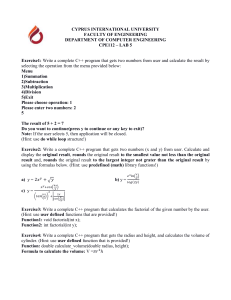


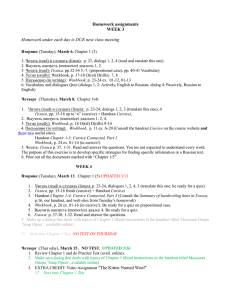
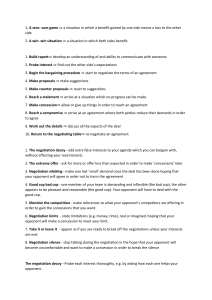
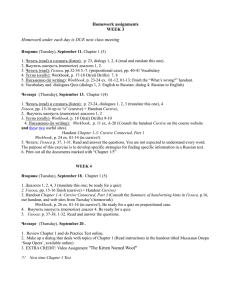

![[Bruker 2006] Introduction to X-ray Fluorescence (XRF)](http://s1.studylib.ru/store/data/006238700_1-ea3a89e73863f4e8ecf6d44604e5360f-300x300.png)
